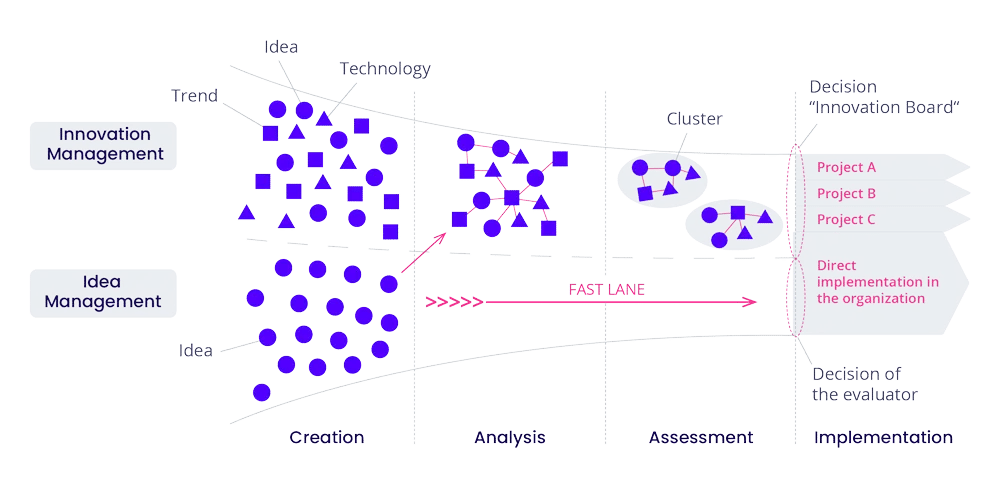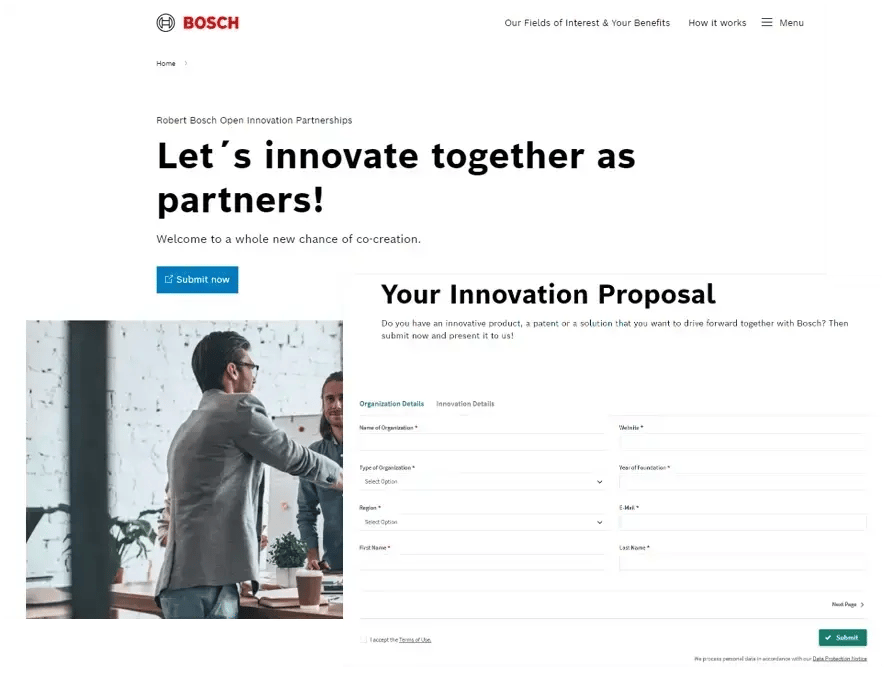A virtual suggestion box is like a well-tended garden—give employees the space, tools, and sunlight of trust, and great ideas will grow.
This article explores how to plant the right suggestion box system, nurture ongoing feedback, and harvest real innovation that boosts engagement, improves processes, and strengthens your company culture.
Why use a digital suggestion box?
A digital suggestion box gives every employee a voice, whether they work in the office or remotely. It creates a clear and accessible way to share ideas, raise concerns, or highlight issues, without adding to their to-do list. It’s quick, practical, and designed for regular use across different departments.
Unlike physical suggestion boxes that gather dust, digital systems support faster follow-up and easier tracking. They protect anonymity while still supporting open communication and real action.
Employees can share sensitive issues confidently, knowing their input won’t be lost or ignored.

These platforms help managers collect feedback and spot new ideas fast. With every suggestion stored and searchable, prioritizing, responding, and moving into the right idea management process becomes much easier. For example, KSB reduced processing time by 60 percent.
What is an effective suggestion box?
An effective suggestion box makes it easy for employees to speak up and expect to be heard.
It invites useful input by being visible, easy to use, and built into daily routines. Clear expectations and quick feedback loops are the key ingredients.
People share more when they know their time is respected. That means fewer long forms, more space for direct thoughts, and fast responses that show suggestions matter. The best systems balance fast employee feedback sharing with enough structure to move ideas forward.
When employees see ideas turn into improvements, they’re more likely to keep contributing valuable employee feedback. Over time, it builds trust, confidence, and a steady stream of great ideas.
A suggestion box: The best tool for fostering continuous improvement
Small, steady steps often lead to the biggest improvements. A suggestion box helps surface ideas and fix frustrations before they turn into bigger problems. It’s a simple but steady way to build better working conditions every day.
By giving employees space to offer feedback regularly, you open the door to more ideas and more engagement. It helps keep employee feedback flowing across teams and roles. Continuous improvement needs to be a habit, and the suggestion box makes it stick.

Suggestion box as employee surveys: Driving honest feedback collection
Surveys give structure. A virtual suggestion box provides the entrance for constant inflows. Together, they create a more complete picture of employee experience.
When people can write what they want, in their own words, you hear what really matters—whether it’s about job satisfaction, team dynamics, or ideas for improvement. Having an option to gather anonymous feedback builds a safer environment where people feel comfortable being honest.
A strong feedback system includes both formats. Surveys show trends; suggestion boxes uncover the why.
The role of employee engagement in innovation
Innovation thrives in environments where employees are engaged, curious, and confident they’ll be heard. When people feel needed in shaping their workplace, they’re more likely to notice opportunities for improvement. That connection turns everyday experience into valuable suggestions.
Employee engagement is about active participation. Engaged employees don’t just follow instructions; they ask questions, offer ideas, and want to make things better.

This mindset feeds a culture of innovation and keeps momentum strong across teams.
Building a feedback loop that values input is a simple yet effective way to nurture innovation. The more employees are encouraged to contribute, the more potential there is for continuous improvement.
Why engaged workforce members contribute better ideas
An engaged workforce pays attention. People who feel connected to their company’s goals are more likely to identify challenges and propose relevant, constructive feedback. These are the insights that help solve real problems, not just surface-level concerns.
When employees care, they look out for each other—and for customers. They see how processes affect outcomes and suggest better ways to do things. That’s where great ideas often start: with someone who understands both the issue and the impact.
Keeping employees involved isn’t just good for morale—it directly supports the quality and relevance of the suggestions you receive.
Using suggestion boxes to drive higher engagement
Suggestion boxes make it easier to encourage employees to participate without needing a formal meeting or process.
This open communication tool lowers the barrier to entry and shows that management values employee input. When suggestions are acknowledged and acted on, engagement naturally rises.

Employees feel more connected when they see their ideas make a difference. A simple comment can spark bigger conversations. Over time, the suggestion box becomes a quiet force behind employee satisfaction.
Consistency matters most. Encourage regular participation, and make it clear that suggestions won’t disappear into a void. Every management follow-up builds trust.
How suggestion boxes improve company culture
Company culture is shaped by how well people listen and how often they act. A suggestion box invites ongoing, two-way communication between employees and management. It gives structure to feedback and helps surface issues that may otherwise go unnoticed.
Better working conditions, higher employee morale, and more responsive leadership are all outcomes of a strong suggestion system.
People feel safer bringing up sensitive issues when they know there’s a reliable process in place. And when employees feel valued, they’re more likely to invest in the organization’s success.
It’s not about collecting feedback for the sake of it. It’s about showing employees that their voice helps shape the way things are done.
How to set up an effective employee suggestion box
Start with a simple goal: make it easy for employees to share ideas and concerns.
A good suggestion box process is visible, quick to use, and supported by managers who are ready to listen. Clear communication about how suggestions are reviewed and acted on builds trust from the beginning.
Employees need to know their ideas won’t be ignored. Involve teams early by asking what kind of employee feedback matters most to them. Let them see how their input is connected to real change within the workplace culture. Post submission forms on sites where they regularly are.

Make it a regular habit, not a one-time initiative. When feedback becomes part of how things are done, everyone—managers included—stays involved and focused on improvement.
Physical or digital suggestion boxes: Which works best when?
Physical boxes work best in settings where employees don’t have regular access to devices or where quick, anonymous input is needed on-site.
They’re simple to set up and offer a low-tech option that still supports communication. But they can be slow and easy to overlook without follow-up, not continuously boosting employee engagement.
Digital suggestion boxes save time and are easier for managers to track and manage. They support real-time employee feedback and work well for remote or hybrid teams.
For most companies, digital tools are more scalable and easier to maintain on a regular basis.
Features to look for in modern suggestion box software
Modern suggestion box software eases the idea collection and analysis. It allows for the collection of anonymous feedback, encouraging honest input from all employees, not just the most vocal ones.
Easy submission forms, mobile access, and communication features help keep employee feedback regular and natural. At best, submission forms can be easily embedded on sites where employees regularly are.
Management needs features to organize suggestions, group common themes, and prioritize what matters most.

AI features and built-in tracking and status updates let employees see where their ideas stand, helping them feel involved in the process. Alerts, reminders, and dashboards can support better communication between teams and leadership.
Most importantly, choose a system that helps the company respond quickly. When feedback leads to visible improvements, employees stay motivated to share more.
The right features make suggestion management easier for everyone—without extra effort or lost ideas.
Gathering employee feedback that fuels change
To make feedback meaningful, employees need a clear, simple way to provide it.
A well-designed suggestion form—whether part of a physical suggestion box or a virtual suggestion box—can capture real concerns and spark useful ideas. But forms alone aren’t enough; what fuels change is a process that shows management is listening and acting.
Start with consistency.
Invite employees to share employee feedback on a regular basis, and make the feedback system easy to access. A free suggestion box tool can be a good starting point for companies without a large budget.
Creative ways to encourage higher employee engagement and participation
To encourage employee engagement, go beyond posters and announcements.
Try team-based idea challenges to gather suggestions on a shared topic, or highlight one idea per week in a company update. This helps make participation feel social, visible, and rewarding.
Another strategy is to share a small example of how one employee’s feedback led to a change. When others see that speaking up works, they’re more likely to join in.
Turning employee feedback into actionable innovation projects
Ideas alone won’t change much—execution is key. Use categories on your suggestion form to help management sort feedback into quick wins, long-term improvements, or innovation opportunities.
This helps teams focus on what’s possible now while capturing ideas that need more planning.
Feedback should be reviewed regularly and followed by updates. Even small steps forward signal progress and show respect for employee input.

Honest feedback vs. anonymous feedback: What’s more valuable?
Both have benefits and potential drawbacks. Anonymous feedback promotes openness but can make follow-up harder. Honesty, named input supports better dialogue but may be limited if employees fear consequences.
Offering both options through a physical or digital system gives people the choice. A hybrid setup balances transparency and safety, helping more voices be heard.
Overcoming barriers to employee participation
For a suggestion box to succeed, employees must feel safe, supported, and heard.
A lack of transparent communication, unclear goals, or poor follow-up often discourages participation. To build trust, make the system visible, explain how it works, and highlight how constructive input has led to real change.
Creating a safe space matters just as much as the tool itself. Employees are more likely to contribute if they believe their ideas won’t lead to judgment or consequences.
Encourage questions, not perfection, and respond to feedback with care and consistency.
How to encourage the submission of suggestion box ideas continuously
Make idea-sharing part of how the team operates—through gentle reminders, regular prompts, or fun challenges tied to relevant topics. Using a mix of tools, such as a physical suggestion box in shared spaces and a digital one for hybrid teams, can help everyone participate.
Showcasing a weekly example of a submitted idea, especially one that sparked a change, reminds people that their voice matters. Visibility helps build momentum.

Combatting suggestion fatigue: Keep employees engaged
Even the most motivated employees lose interest if nothing happens after they submit ideas.
Keep energy high by acting quickly on small wins and reporting progress on bigger ones. Every update should connect the feedback received to the action taken.
Offering recognition and small rewards can also help. Let employees know their effort is appreciated, whether or not the idea is implemented.
When suggestion boxes fail—and how to avoid yours failing
A suggestion box can be a powerful tool—or a forgotten bin of ideas.
Common reasons for failure include lack of follow-up, poor design, or unclear purpose. To succeed, set clear goals, assign ownership, and regularly review suggestions.
Clarify the potential benefits of participation. Make it easy to create and submit ideas, and remind employees that their input isn’t wasted—it’s driving change.
Best practices for managing employee suggestions
A well-run suggestion box system doesn’t stop at collecting ideas—it creates a cycle of feedback, action, and recognition.
To manage this process effectively, companies need structure and clarity. Every suggestion should be reviewed promptly, tracked transparently, and linked to clear follow-up steps.
Setting clear guidelines for suggestion submissions
Good input starts with good instructions. Clear submission guidelines help employees understand what kind of new ideas are useful and how to communicate them. Keep the focus on constructive, realistic suggestions that support team goals or solve real problems.
By offering examples or a simple submission format, you make participation easier and more consistent. This also improves the quality of feedback and speeds up evaluation.
How to evaluate and prioritize suggestions
Not every idea can be acted on, but each one deserves a fair look. Use criteria like impact, feasibility, cost, and alignment with business goals to rank suggestions.
A structured review process helps maintain momentum and prevents good ideas from being overlooked.
Share updates on which suggestions are moving forward and why. This encourages trust and keeps the system credible.
Recognizing and rewarding valuable employee suggestions
To foster employee engagement, it’s important to show appreciation. Recognition can be public praise, small rewards, or simply acknowledging the contribution in a team meeting.
Even a quick thank-you reinforces that the suggestion box isn’t just a formality—it’s part of a culture of continuous improvement.
Over time, recognition helps build habits of sharing and collaborating on workplace improvements.
Guaranteeing and measuring the impact of your suggestion box
To show the value of a virtual suggestion box, you need to measure more than just the number of submissions. Focus on the quality of suggestion box ideas, how many lead to action, and their impact on workflows or cost savings. These metrics prove the tool’s contribution to continuous improvement.
KPIs to track continuous improvement through suggestions
Key performance indicators (KPIs) might include idea implementation rate, average response time, and participation rate across teams.

You can also track trends in the types of ideas submitted to identify recurring issues or innovation themes. These numbers help demonstrate progress and highlight areas where you need more engagement.
From feedback to outcomes: Closing the suggestion loop
Feedback without follow-up leads to silence. Close the loop by regularly updating employees on what’s been done—and what’s next.
This builds trust, improves the quality of feedback, and increases success, especially when using crowdsourcing platforms to engage larger teams.
Building a sustainable suggestion box program
A sustainable suggestion box system needs more than a one-time launch. It requires ongoing visibility, regular communication, and a shared commitment between management and teams.
The most important thing is to treat the box not as a side project, but as a real part of how your company grows and improves.
Keeping momentum: How to keep employees submitting ideas
People stop using a system when nothing happens. To keep ideas flowing, provide feedback consistently—thank employees for their input and show them what’s being done.
Sharing a weekly example of an idea that led to change is a great way to boost employee engagement.
Small rewards or recognition can also go a long way. And if you’re just getting started, a free suggestion box tool can help test ideas before investing in more advanced solutions.
Scheduling regular reviews and integration into core business processes
Make reviewing suggestions part of your team or department meetings. Assign ownership so no idea goes unnoticed. The best results come when feedback is linked directly to everyday decisions, not kept separate from real work.
Tie employee ideas to company goals, customers, and operational improvements to show their real value.
Long-term strategies for evolving your suggestion program
Over time, upgrade your process with smarter tools, feedback analytics, or even internal challenges to solve specific problems. Keep adapting the program to meet employee needs and business priorities. Sustainability depends on relevance—so let the system evolve as your company does.
Start your new employee suggestion box. Today.
The ITONICS Innovation OS is the best employee suggestion box software. It provides a home to collect feedback and encourage participation continuously.

Eliminate information silos: Dispersed teams and disconnected data often result in missed opportunities and duplicated efforts. With ITONICS, all your innovation projects, most innovative ideas, and market insights are centralized in one place. Create transparency and reduce inefficiencies by keeping everyone on the same page.
Streamline idea and feedback collection: Managing a high volume of ideas from various sources can be overwhelming. ITONICS allows you to capture, evaluate, and prioritize ideas from across the organization, including customers and partners, all in one structured process. This helps focus resources on the most impactful ideas and reduces time wasted on less promising ones.
Track innovation progress across teams: Monitoring the progress of multiple innovation projects across departments isn’t easy. ITONICS provides visual dashboards and roadmapping that give you a real-time overview of ongoing projects, ensuring you can quickly address roadblocks, identify risks, and keep everything on track.





